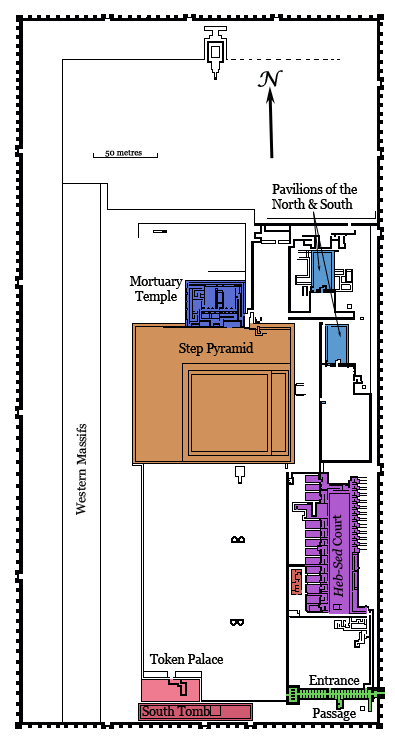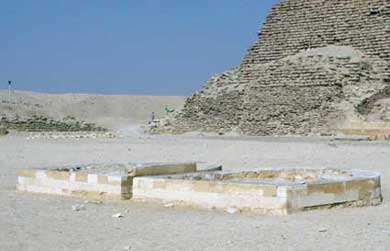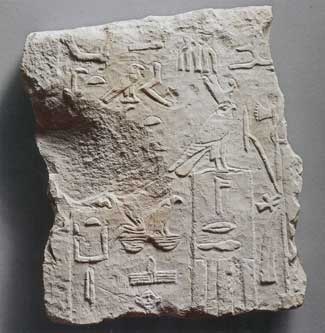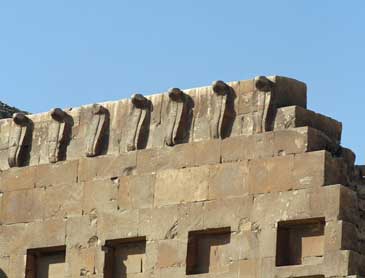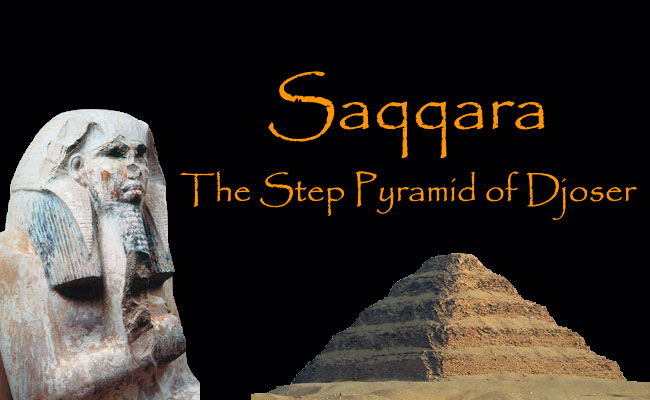
THE GREAT COURT
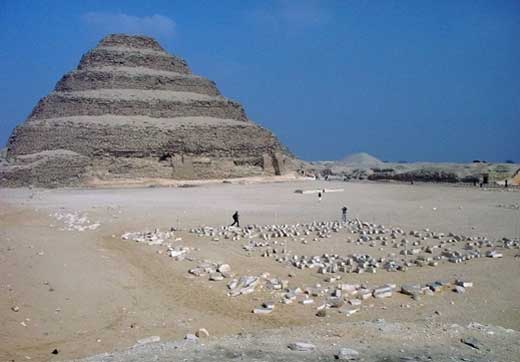
The Great Court from the Southwest
The Great Court (or South Court) was a huge area measuring 187 x 108 metres and was enclosed by ‘palace facade’ walls. It probably replicates the area in the complex of the royal palace where the pharaoh would display himself to his people, receive the tribute of foreign lands, etc. Against 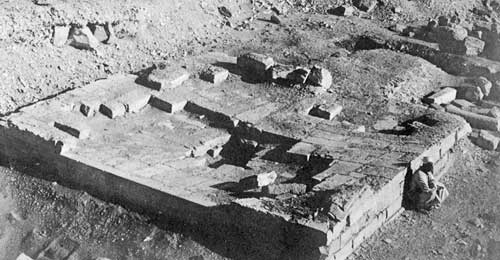 the south side of the pyramid was a throne dais (left), approached by a ramp or a set of stairs. At the base of the ramp More or less in front of it and near the centre of the courtyard were two pairs of horseshoe-shaped structures, set about 60 metres apart. This architectural arrangement is depicted on a number of objects from the Early Dynastic period, including a macehead belonging to Narmer, found in the Main Deposit at Hierakonpolis, and an ebony label for a jar of oil recovered from the Tomb of Den at Abydos. The scene is thought to represent an episode in the Heb-Sed, a ceremony that was held in the thirtieth year of the pharaoh and at frequent intervals thereafter.
the south side of the pyramid was a throne dais (left), approached by a ramp or a set of stairs. At the base of the ramp More or less in front of it and near the centre of the courtyard were two pairs of horseshoe-shaped structures, set about 60 metres apart. This architectural arrangement is depicted on a number of objects from the Early Dynastic period, including a macehead belonging to Narmer, found in the Main Deposit at Hierakonpolis, and an ebony label for a jar of oil recovered from the Tomb of Den at Abydos. The scene is thought to represent an episode in the Heb-Sed, a ceremony that was held in the thirtieth year of the pharaoh and at frequent intervals thereafter.

Rollout Drawing of the Narmer Macehead
There is a persistent notion of the royal sacrifice in early kingship, particularly African kingship. The belief existed that the right order of the world was directly related to the physical prowess of the king—his sexual potency, his strength and his valour. When these began to wane, he was sacrificed and a younger, more vital candidate was put in his place. One way of demonstrating whether or not a person was fit to rule was through contests. Perhaps duels to the death and may the best man win—there is certainly enough literary evidence to support that notion. If that had once been the case, it was certainly not by the time Egyptian civilization had begun. But perhaps there were other demonstrations of vitality, such as beating the boundaries of the Land or sacrificing to all of the gods of the Land, that served in its place. By the dynastic period, these activities had been gathered into a single 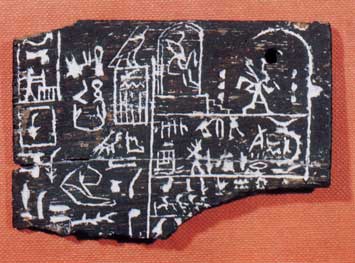 location, adjacent to the royal palace, where temporary structures were set up in a large open space. Evidently Djoser considered it important that he (or, in this case, his ka) should be able to perform these same rites in perpetuity, in the Afterlife.
location, adjacent to the royal palace, where temporary structures were set up in a large open space. Evidently Djoser considered it important that he (or, in this case, his ka) should be able to perform these same rites in perpetuity, in the Afterlife.
On Den’s label (right), he is shown twice—once sitting on his raised dais, wearing a tight fitting mantle, similar to what Djoser is wearing in the statue from the Serdab. He is gazing out onto an open space where another version of himself, wearing the traditional kilt, is seen striding (or loping or dancing) between two sets of semi-circular structures, just like those in the courtyard.
THE TOKEN PALACE
In the south-western corner was a dummy building known at the Token Palace. It is pretty much the first thing that catches your eye when you emerge from the Entrance Passage. It probably represents the temporary pavilion set up for the pharaoh to rest and refresh himself at certain points in the rituals (which were undoubtedly long and tiring, especially under the fierce Egyptian
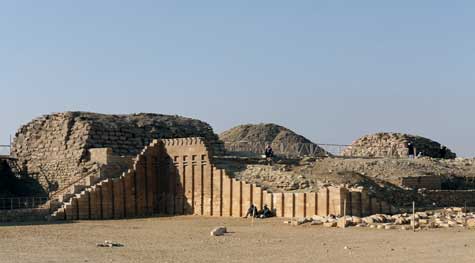
The Token Palace
sun. The exterior was decorated with a façade that mimicked reed matting and was topped by a frieze of cobras with their hoods flared, poised to strike. This was the uraeus, the symbol of Wadjet, the great goddess of the Delta city of Buto, patroness and protector of the pharaoh. The same image is part of the royal headgear, where she sits on his forehead, poised to strike out at his enemies.
The building is almost all solid masonry but an entrance on the north side leads into a small room, which Lauer believes once held a statue of the pharaoh. Ricke, on the other hand, thinks that it was used to house the crowns of Upper and Lower Egypt. You pay your money and you take your choice.

